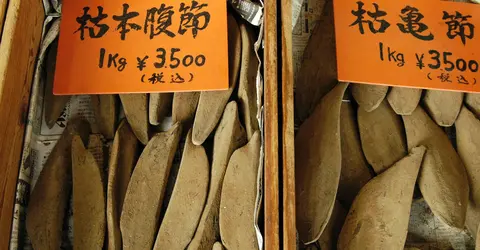Katsuobushi 鰹節
- Published on : 02/03/2018
- by : A.R
- Youtube
The key ingredient
You may not know it by name, but if you're a fan of Japanese cuisine, you'll have surely tasted it. This mysterious ingredient is katsuobushi, or bonito flakes, an essential but often overlooked Japanese ingredient.
It's actually skipjack, a type of tuna, called katsuo in Japanese, which is dried, fermented and then smoked to create the popular katsuobushi. This ingredient is full of umami, that is, the fifth flavor of Japanese cuisine, after sweet, salty, acidic and bitter. Umami means tasty, or savory, and one of its particularities is to give a lasting aftertaste, which allows it to improve the flavor of many foods.
And katsuobushi fulfills that role well: it's used as a filling in onigiri (rice balls), as a garnish for hiya-yakko (cold tofu) and is key in furikake (rice seasoning made of sesame seeds and seaweed, among other things), and a topping for takoyaki (small fried dough balls with octopus) and okomiyaki (a kind of Japanese cabbage pancake). Katsuobushi is also and perhaps most importantly used when making dashi, which is itself one of the key ingredients of Japanese gastronomy. In fact, dashi is found in most sauces, noodle dishes and broths, including the famous miso soup. So you see, you will have a hard time visiting Japan without consuming pounds of katsuobushi, whether you realise it or not, as it's present in most dishes - so vegetarian friends, be careful!
European travellers, enjoy your stay and eat your fill, because Japanese katsuobushi isn't found in the EU due to strict European food standards (any you find there will be from China, Korea or Vietnam). You can always stock up at the supermarket while in Japan: while originally it resembles a piece of wood and is considered the hardest food in the world, it is usually sold in the form of thin pink shavings, in plastic packets. Like wine and cheese, the longer the fermentation time, the higher the price: you will be able to choose between the cheapest type, arabushi (only smoked and dried), karebushi at a higher price (with a short fermentation) and the Rolls Royce of katsuobushi, honkarebushi. Happy tasting!

Katsuobushi in it's natural form!
Daisuke Matsumura













